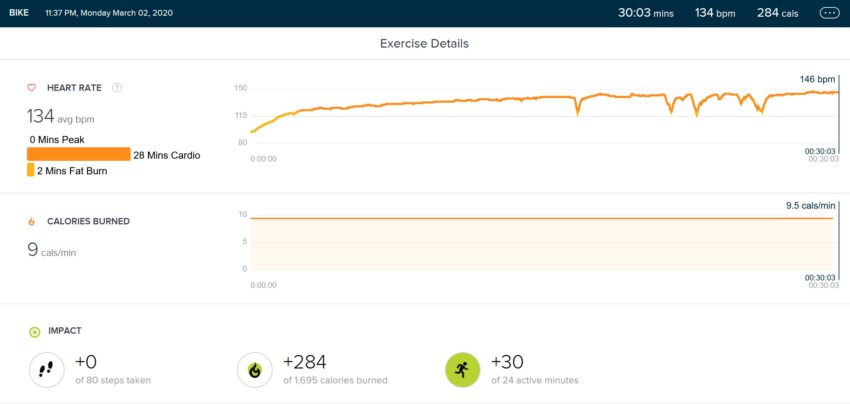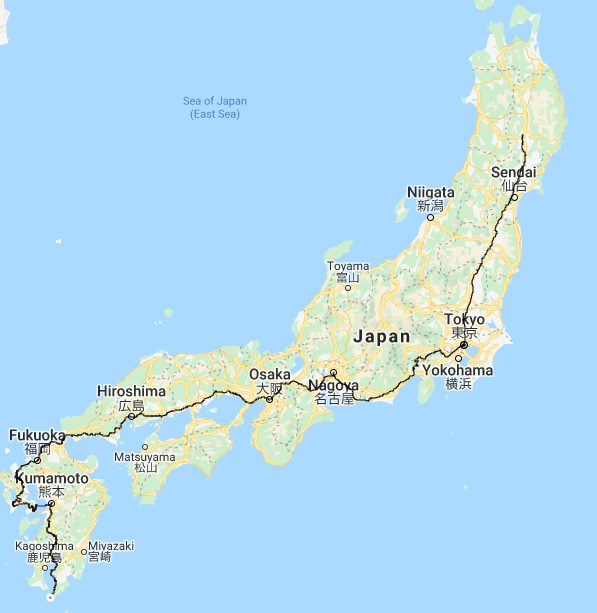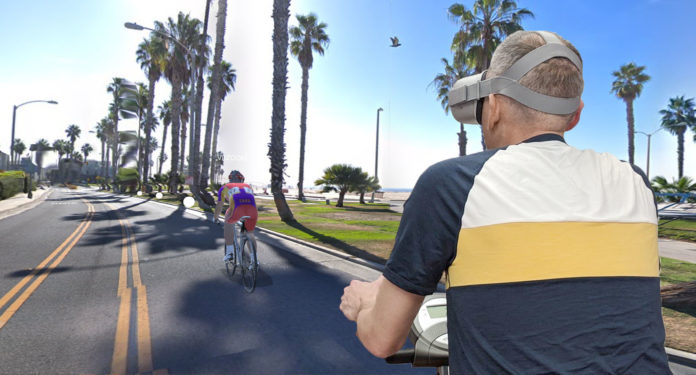The VZFit is a unique accessory developed by Virzoom that allows for any stationary bike to be connected wirelessly to an Oculus Quest or Oculus Go headset. The hardware package consists of a Bluetooth pedal mounted sensor and a simple Bluetooth controller. Check out my complete and comprehensive VZFit hardware review for an in-depth look at the hardware itself. With the sensor installed on your bike and paired to your headset you can then use your bike to access and play through Virzoom’s two apps, VZFit Play and VZFit Explorer, available together via a monthly $9.99 or annual $99.99 subscription. In this review, I will focus exclusively on VZFit Explorer, which represents Virzoom’s Google Streetview ride app. If you’re interested in the games that VZFit offers then check out my VZFit Play review.
The Ultimate fitness travel app?
Of all the experiences that wowed me when I got my first Oculus Rift headset back in early 2017, my favorite was Google Earth VR. Having the entire planet at my fingertips to literally dive down into and explore was incredible. I could go anywhere, Mount Everest, the Eiffel Tower, the Golden Gate Bridge, the Grand Canyon, wherever I desired to go was just a click away. Yet ultimately, it wasn’t the world’s natural wonders and amazing megacities that hooked me and got me to devote hours inside the app. It was the mundane, almost banal simplicity of standing on the roof of my own house in Devon, England, surveying the familiar view and then leaping off like Superman to fly down local streets to visit my friends, family, workplace and nostalgic haunts from my childhood. Even now, three years on I still load the app up often and fly to local vantage spots, enjoying the sea views and rural countryside surrounding my pretty, if otherwise nondescript home town. Perched like a bird (always a seagull or a pigeon in Torquay!) on a pylon or church spire I find surveying my own remote corner of the world this way to be a meditative, calming experience and one I’ve never tired of.
For me, VZfit Explorer captures this same feeling, simultaneously evoking feelings of grandeur; exploring the entire world, and a comforting nostalgia; cycling from my own front door to the house I grew up in. It’s both a workout tool and a travel app rolled into one and I have to say I personally love it. The experience isn’t without its flaws however so I want to spend some time addressing those, giving prospective customers a clear idea of both what the app is capable of, as well as its limitations.
A rough diamond
Explorer utilizes Google’s Street View technology and applies some magical wizardry that attempts to convert the static two-dimensional photographs into full motion, 3D-ish environments for you to cycle through. There is a large caveat here. It’s not perfect, and there are some noticeable graphical distortions at times. These are inevitable given that the source material is flat photographs, so even though the developers at Virzoom are constantly updating their methods, don’t expect dramatic improvement here.
That said, when it works, it was possible to feel immersed to the point that after taking the headset off, my memories were of having gone on an actual bike ride. I found this especially true when creating rides that involved locations I personally know well. Cycling across the open moorland of Dartmoor, near my home there were moments when I could easily believe I was there; its barren hills, rocky outcrops, and distant granite tors might not be quite as pleasing in VR as in reality, but it’s a decent enough substitute that comes without the hassles of enduring the real-life perennial rainfall and the 15-mile car journey to get there.
Then I’d try a route through a busy city center and the visuals would distort and twist into an unsightly mess. Virzoom has recently released a new ‘city mode’ that replaces the real road with an animated one. This eliminates the problem of driving over strangely flattened cars but also kills some of the immersion and overall visual appeal so I prefer to stick to the ‘country mode’, which renders the entire scene and stick to cycling in areas where the visuals work well. Generally, if you’re riding in the wide-open country, with few cars and limited near roadside objects VZFit Explorer looks great. If you’re in built-up areas with lots of cars and near roadside objects, then there will be times where it doesn’t. Homogeneous structures like cliff walls, rows of identical trees and terraced houses render really well and actually look 3D as you ride past them. If the scenery is varied, however, maybe a roadside fence with some houses placed further back, and at different elevations from each other then the images can become distorted. Try to imagine what a house would look like if the downstairs half was near to the road and the roof a hundred meters further back. You will get these kinds of distortions quite often in built-up areas whilst playing Explorer.
A VZFit community member and regular Explorer rider Karen Cosimano kindly uploaded videos of some of her recent rides to Youtube for me to use with this article, so you can really get a good idea of what the visuals look like when riding for extended periods.
The first video below shows a custom map Karen created herself. Like custom Beat Saber songs, being able to make your own routes is VZFit Explorer’s greatest attribute and means it has near infinite replayability.
If you go to the 9:40 mark on the video below Karen switches to ‘city mode’ so you can get a look at how that works.
Hopefully, those videos provide you with a realistic expectation of how the app performs. Note that watching these on a monitor or phone screen highlights what the distortions can look like, but it doesn’t capture the expansive sense of presence and immersion that VR gives you. In the headset, although the distortions can look bad at times, being ‘inside’ the world and able to look all around feels great. The app’s potential greatly outweighs its limitations and the odd piece of visual weirdness really doesn’t bother me that much.
Preparation
For my fitness test, I chose to visit the frozen wilderness of Alaska and begin a popular suggested ride on VZFit Explorer, some 93 miles long. I typically ride for 30 minutes at a time, covering around ten miles, so this playtest represents one of probably nine stages I’ll need to ride to complete the route. I selected a female trainer to accompany me on the ride, and wore a sweatband, along with a wipeable VRCover. My bike has its own computer with various programs and I set up a thirty-minute rolling hills ride to give me some resistance variability as it simulates a series of small climbs by gently increasing, then decreasing the watt resistance.
Thanks again to Karen for uploading part of her own Alaska cycle for me so you can see the route I took.
Intensity 8/10

- Calories burned: 284
- Calories per minute:9
- Average heart rate:134
- Max heart rate:149
- Steps:N/A
- Active Minutes:30
Note that the heart rate drops were probably a result of the program I set my bike to which included some lower wattage recovery sections. Obviously, if I raised the bike’s resistance or pedaled harder I would have got my heart rate up a lot more. However for me at least, although it’s certainly possible to push as hard as you want in Explorer, I found that unlike VZFit Play, where the race game I play tested compelled me to push harder, here I naturally prefer to amble along enjoying the scenery and just putting in some active time.
Arms 1/10
This is cycling, so unless you’re using an Airdyne your arms are not being worked at all. Of course, this isn’t a problem as almost every other VR fitness game focuses almost exclusively on arm and shoulder work. The Thrill of the Fight , Beat Saber and BoxVR are still the best recommendations for a great arm and shoulder workout.
Legs 9/10
Cycling is fantastic for working your legs, toning the calf muscles and, if worked at a high enough resistance, for adding some nice muscular definition to the quadriceps. If toned, lean legs are a goal for you then cycling virtual miles in Explorer will definitely help in that pursuit. As the leg muscles are a major muscle group, working them makes for an excellent aerobic activity and cycling is a proven way to expand your lung capacity and improve your cardiovascular health. It’s also a great low impact way to burn calories and lose weight. In short then, like its sister app VZFit Play, Explorer can be a great corrective to the likely arm/shoulder workout emphasis imbalance that you might encounter if your fitness regime is exclusively VR based.
Core and Balance 5/10
To a large extent how much core activation you experience will depend on the type of bike used. If you use VZFit Explorer on a real bike with a trainer or spin or upright bike then your core muscles will be activated by you maintaining good form, keeping your back straight and balanced, and by leaning sideways into turns. If you’re on a recumbent bike, however, you won’t be using your core much at all.
Time Perception 9/10
Whilst using an indoor bike is usually a tedious monotony, cycling on a real bike along country lanes and coastal paths is a fun, relaxing and healthy pastime loved by many. Explorer does a fantastic job of capturing that ‘real ride’ feel allowing you to recreate virtually the kind of bike rides that are a joy to do in reality. You’re cycling through the real world so the scenery is of course as rich and varied as the locations you select. You can absolutely lose yourself as you race down the winding forested mountain paths of Mount Rainier, or marvel at the beautiful scenery as you cycle through Ireland’s famed Gap of Dunloe. With the whole world to see and explore and something new always just around the next corner, it’s easy to begin a 20-minute cycle and end up doing an hour or more. I actively look forward to my workouts in VZFit Explorer and find it not only engages my mind but relaxes me too.
Replayability 10/10
You can cycle the entirety of GoogleStreetview. That’s almost every country on Earth and according to Google 10 million miles of roads! If driven in a straight line that’s a distance equal to circling the earth over 400 times. Explorer lives up to its name then and can turn every workout into a little adventure. Some regular users are now creating epic rides of hundreds, if not thousands of miles. Shon Tamblyn is one such rider, who has spent the past few weeks cycling the length of Japan. This ability to convert your exercise sessions into a global exploration means VZFit Explorer is simply without a rival when it comes to generating replayability.

Fitness Scalability 8/10
As I said in my review of VZFit Play, the capabilities of the bike you are using will have the largest impact on scalability, but even so, Explorer has a variety of options to mix up your workouts. If all you want is a gentle ride admiring the bucolic beauty of rural Ireland then that’s fine. If you prefer to be put through your paces then select a computer trainer to accompany you and suffer as they put you through an interval or HIIT session. The trainers are well animated and provide some friendly encouragement and chatter that helps liven up the session. Spin Cycles can be adjusted meaning you have to pedal more or fewer revolutions per minute to complete one.
Lack of Nausea 7/10
Like its sister app VZFit Play, Explorer utilizes body leaning to steer your bike. Because you are initiating the movement yourself it greatly reduces the risk of motion sickness. It works well, and despite being moderately susceptible to motion sickness in VR, I have never felt even a little queasy in VZFit Explorer. The app does suffer the odd jarring moment, however. Occasionally the Streetview image won’t update in time and you’ll cycle right through a house or a concrete wall. At other times there may be a missing Streetview image along the road and you will jump instantly to the next one. Finally, because you lean to steer, if you are cycling down a particularly winding road you might not quite make the turn and slide off into some trees. These moments might startle a newcomer, but personally I kind of like them!
Social Competition 8/10
VZFit Explorer features multiplayer so you can cycle with a friend and even chat as you ride along. I say friend deliberately as you won’t find any random strangers online to jump into a ride with. The userbase is obviously small as you’d expect of a niche product, and this is compounded by the fact that the vast majority of users will be using the app for a workout and then logging off. That said, there is a VZFit Facebook community group with some friendly regulars who like to ride with somebody and you can arrange to cycle with them, and of course, if you have a real-world friend or partner who also has VZFit then setting up rides together will be an excellent motivational enhancer.
There are global leaderboards for distances cycled (counted in spin cycles) and rankings for finishing the suggested rides. The ability to upload your own created rides for others to use is another excellent feature that helps build up a sense of community. If you’re proud of your homeland and its picturesque views, create and upload a route and invite others to check it out!
VRFI Fit Score 9.5/10
It has a few rough edges and throws up some dodgy visuals at times, but these quibbles aside VZFit Explorer is a superb application for those serious about their fitness and health, and who want to make indoor biking part of their active lifestyle. The subscription cost of $9.99 a month is not trivial. The price is competitive compared to traditional fitness subscription models like Pelaton and Zwift but you will also need to purchase the VZFit hardware (another $100 although discounts are common) and of course, if you don’t own one already will also need to buy a bike as well. Whether the expense is justified is, of course, a subjective assessment for you to make yourself. Having used the product for four months now I can honestly say that VZFit Explorer has become an essential part of my exercise routine and maybe the favorite app on my Oculus Quest.
The Good
Brings the outdoors to your indoor biking sessions.
Unrivaled replayability with millions of miles of roads to cycle.
More than just an exercise app, this truly lets you ride the world, explore famous destinations and revisit your favorite real-life places.
Cycling through open countryside and wide-open spaces work really well.
The Bad
Graphical distortions are inevitable at times.
It doesn’t work as well in cities and built-up areas.
Occasional glitches and bugs, especially on user-created rides.
Subscription service won’t appeal to everyone.
You can purchase the VZFit sensor and start using VZFit Explorer by ordering directly from Virzoom. Note only compatible with the Oculus Quest or Go headsets.


